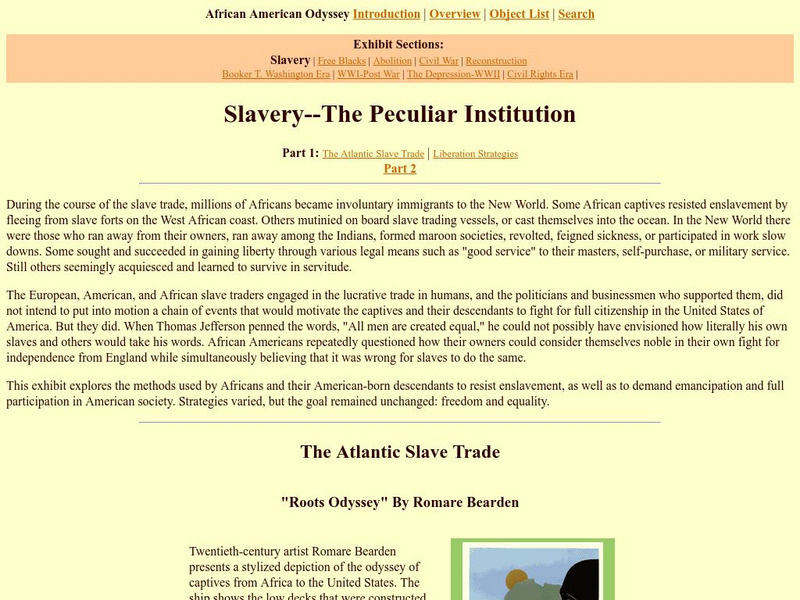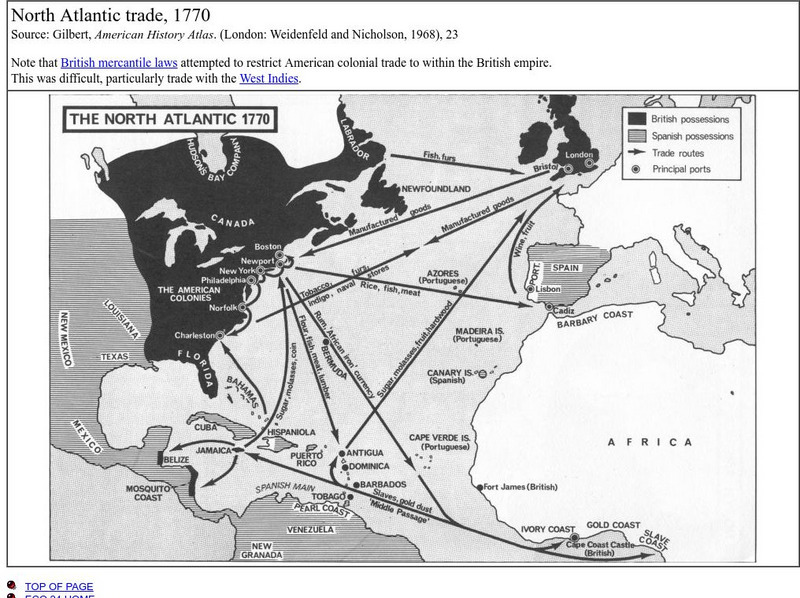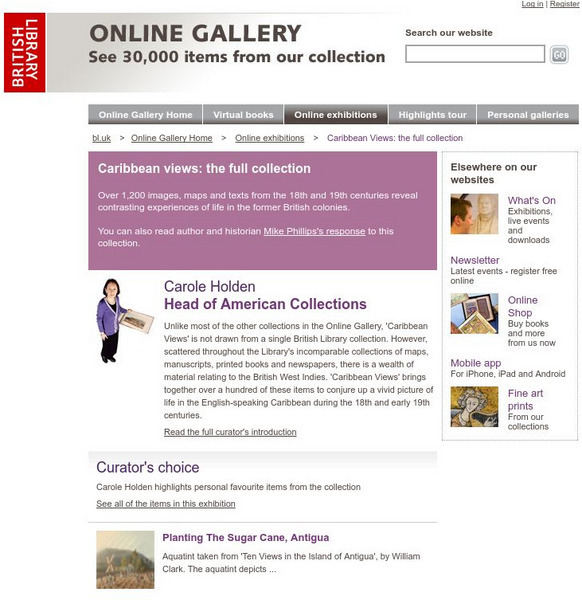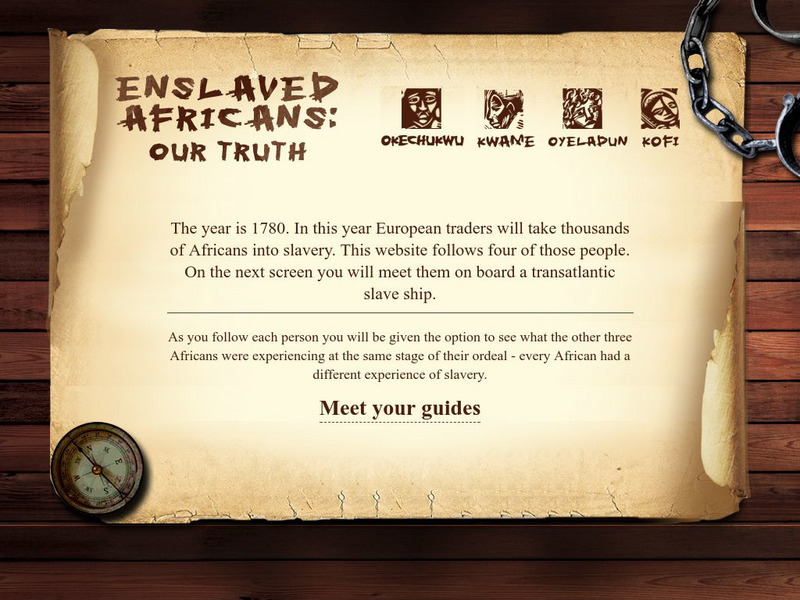Mariners' Museum and Park
Mariners' Museum: Captive Passage: The Transatlantic Slave Trade
Online exhibition from the Mariners' Museum chronicles the plight of African slaves from the beginning of their journey when they are torn from their homeland all the way to the shores of the Americas. Caught up in the lucrative...
Understanding Slavery Initiative
Understanding Slavery Initiative: Trade and Commerce
The transatlantic slave trade lay at the heart of a complex global commerce system between Europe, Africa, and the Americas. Learn about the clash over possessions, and the disputes over each others' presence in the seas.
Stanford University
Stanford History Education Group: The Middle Passage
[Free Registration/Login Required] Lesson plan on the Middle Passage includes PowerPoint presentation and primary source documents from which students explore original material.
Curated OER
Unesco: Why the Triangular Trade as a Topic?
A nice intro into the topic and history of triangular trade. Includes maps and trade routes. Done as a project for Norwegian students.
Digital History
Digital History: The Atlantic Slave Trade
A brief but sobering look at the slave trade and the number of slaves in the New World in the 16th, 17th, and early 17th centuries. Slaves could be found from Nova Scotia to Argentina.
BBC
Bbc: Bitesize History: Industrial Era: Triangular Slave Trade: Interpretations
Discusses the different interpretations that historians have had of the slave trade. It includes a video of Interpretations of the abolition of slavery, questions with answers, and a link to an assessment.
Other
Juneteenth: The Middle Passage
Moving description of the Middle Passage and African American trauma through the perspective of the artist, Tom Feelings.
The History Cat
The History Cat: Us History: The Middle Passage
A detailed look at the trans-Atlantic slave trade that lasted from the 1500s to the 1800s.
Other
School Wires: The Agricultural South [Pdf]
In the Southern colonies, a predominantly agricultural society developed.
Library of Congress
Loc: Slavery the Peculiar Institution
Opposition to slavery was growing as slaves rebelled, mutinied, or ran escaped from owners. View these resistance strategies through the following primary sources that include art, original maps, testimonies, newspapers, and letters.
University of California
Uc Santa Barbara: What Brought the Europeans to America?
Short essay addresses reasons that brought the Europeans to America. Covering many important points, he also provides compelling reasons and a map.
University of California
Antillians: The Growth of Slave Trade
Easy-to-read, colorful maps that show the triangular slave trade routes from 1451 to 1870.
McGraw Hill
Mc Graw Hill: Colonial Economy and Patterns of Society
Although tied to pages from a specific text, these AP study questions allow anyone to consider aspects of colonial economics. (Answers to some of the questions are located at the following link:...
Other
Union College: North Atlantic Trade, 1770
This is a map that shows the trade routes, principal ports, goods being traded, and the areas possessed by the British and the Spanish.
Siteseen
Siteseen: Land of the Brave: Salutary Neglect
Salutary neglect was a long-standing British policy in the thirteen colonies which allowed the colonists to flout, or violate, the laws associated with trade. There were no effective enforcement agencies and it was expensive to send...
Siteseen
Siteseen: Land of the Brave: John Hawkins Facts
Overview and biographical facts on the life of John Hawkins, pioneer of the British slave trade.
British Library
British Library: Caribbean Views
Learn about plantation life during the 18th and 19th centuries by viewing images, maps, and text material in this virtual exhibition from the British Library. Writer Mike Phillips gives his personal interpretation of this exhibit on...
Yale University
Yale New Haven Teachers Institute: Connecticut Blacks in 18th and 19th Centuries
A curriculum unit that examines the history of slavery in Connecticut, the laws permitting it, segregation, and the struggles faced by freed blacks to achieve equality.
Library of Economics and Liberty
Library of Economics and Liberty: Mercantilism
Studies how and why so many countries participated in Mercantilism and the theory behind Mercantilism.
PBS
Africans in America: Living Africans Thrown Overboard
This site is provided for by PBS. In order to receive insurance money, a captain ordered 132 slaves thrown overboard alive. The case went to court, and a landmark decision was made that the Africans on the ship were actually people.
National Museums Liverpool
International Slavery Museum: Slaves' Stories
An intriguing resource that gives first hand accounts of four Africans being taken from their homes and forced into slavery. Click on the pictures of the people to read their unbelievable stories and see artifacts about slavery.
Siteseen
Siteseen: Land of the Brave: Mercantilism
Article provides an overview of mercantilism in Colonial America.
Countries and Their Cultures
Countries and Their Cultures: Herero
The Herero are a Bantu group living today in Namibia and in the Republic of Botswana in southern Africa. The Herero speak a form of southwestern Bantu that is shared most closely by two other major groups. Cattle herding remains the...















